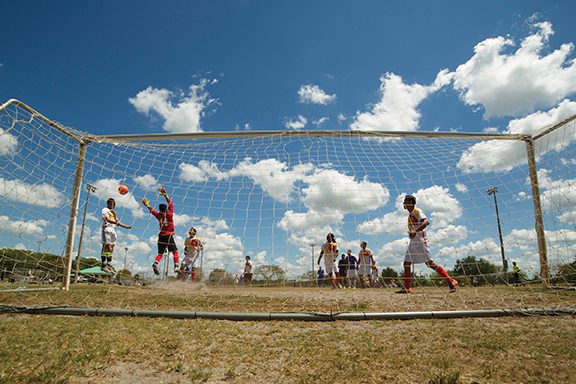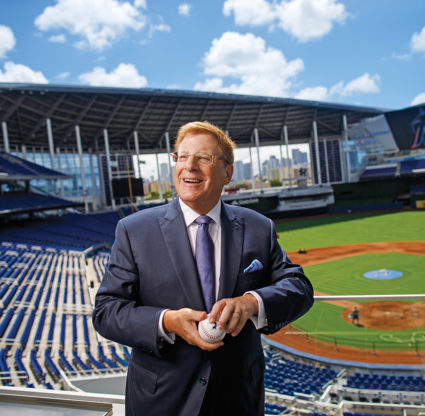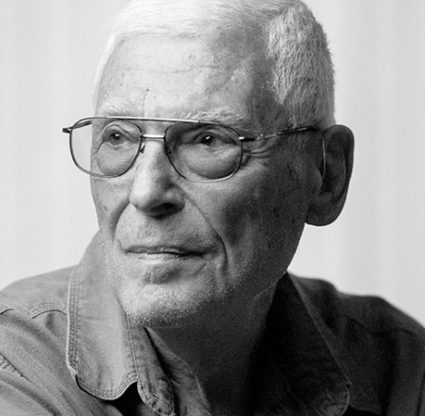 They call it “the beautiful game” for a reason. When everything’s clicking, when all of the cogs in the machine are aligned, when all cylinders are firing in rhythm, you can be lifted to a higher plane of existence, a place where time slows and you can sometimes feel the ions suspended in the air crackle across the hair on the back of your arms.
They call it “the beautiful game” for a reason. When everything’s clicking, when all of the cogs in the machine are aligned, when all cylinders are firing in rhythm, you can be lifted to a higher plane of existence, a place where time slows and you can sometimes feel the ions suspended in the air crackle across the hair on the back of your arms.
It is a feeling I had when my team, cobbled from friends and friends of friends, played against a team known as “The Polish Team” because the core of their squad was from Poland and many of their other players were European. The Polish Team had dominated every other team in our league, and they played with a certain swagger.
It wasn’t unusual to see them start guzzling bottled beer from their cooler at halftime.
But this night, the beers stayed in the coolers. Our goalie, Zach, was turning away balls left and right, bellowing and pounding his chest. Our back line, anchored by Fletcher and Eddie, supported by a rotating cast of Ashton, Christian, Raghu and me, was solid.
Mark, aggressive and incisive, was running circles around guys in midfield and making plays that left the rest of our mouths hanging open. Jovany owned the midfield with his effortless grace and vision. And Favian, our maestro, patiently awaited his chance to attack the seams in the defense.
Just after halftime, Favian found his opportunity and lasered a ball into a bottom corner of The Polish Team’s goal, giving us a 1-0 lead. Our opponents were shaken. We knew they were used to having their way on the field, and they started to vent their frustration.
Elbows and curses were thrown. As the intensity of the competition flared up, adrenaline spiked. The tension in the air was palpable. They weren’t going to go down without a fight.
On a breezy Naples night in March, Ken Passarella paces the sidelines. His team, the Strikers, is a goal up in a tightly contested matchup against the Brewski’s at halftime. As the players and spectators wait for the start of the second half, a murmur of applause and hollering bubbles up from the other side of North Collier Regional Park as someone finds the back of the net in one of the other four games being played at the same time on this Wednesday evening.
 |
|
North Collier Regional Park hosts soccer leagues including the Gulf Coast Adult Soccer league, made up of such teams as the Latin Cosmos (navy) and AFC International (yellow). |
The whistle sounds to kick off the second half, and the Strikers and Brewski’s continue their back-and-forth battle. The Strikers defense sends a long ball up the left side of the field. Fans in portable lawn chairs cheer on the players. Brewski’s defense stifles the challenge with a long ball of its own. Bodies collide. Players go down hard, but hands are quickly offered to help lift them back up.
The teams steam full-tilt toward what will eventually be a 1-0 victory for Strikers in this Gulf Coast Adult Soccer League matchup. As Passarella watches the back and forth early in the second half, he shrugs his shoulders and utters a phrase that is echoed widely across Southwest Florida: “I just like playing.”
Along with thousands of others in the dozens of adult recreational leagues in Southwest Florida, Passarella makes playing soccer a priority.
The 54-year-old Fort Myers resident guesses that he’s been playing in the league for around 30 years, and he appreciates that the GCASL has an over-40 division, because soccer “is one of the few sports you can keep playing when you’re 50.”
The Strikers and Brewski’s are just two of 11 total teams in the GCASL Over-40 division, which plays traditional 11 vs. 11 on a regulation field with a full officiating crew. In the spring, the league also runs a coed 11-vs.-11 division and several men’s and coed 7-vs.-7 divisions, for a total of eight divisions.
That’s a lot of soccer, but it doesn’t even begin to scratch the surface of what Southwest Florida has to offer. There are men’s, women’s, coed, adult, youth, 11-vs.-11 and 7-vs.-7 leagues all up and down the coast, every day of the week.
One of the largest of those leagues is the Naples Mexi Soccer League. Otherwise known as the MexiLeague, it is renowned for its family atmosphere. On a given Sunday afternoon at Eagle Lakes Park, you can find young children laughing on the nearby playground, bleachers filled with family and friends cheering on the players, and a lunch truck overflowing with snacks and drinks backed under the park’s shade trees.
“They have really good sandwiches,” says Morgan Burke, laughing. Her team, ACL, was scheduled to play in a women’s league semifinal later that Sunday evening. The 19-year-old has been playing in rec leagues since she was 5 “because I’m poor” and can’t afford to play on the more expensive club teams.
“We try to be cost-effective,” says Cristian Niño, who organizes the league along with his father, Miguel. “We have a lot of players from Latin culture, and they don’t make a lot of money. So we try to give back to the community and charge less than other programs.”
On Sundays, you can watch games all day long at Eagle Lakes Park between teams sporting replica uniforms of some of the world’s most famous soccer clubs. The officiating crews for the 11-vs.-11 contests wear official matching gear, as well.
“We want to make sure everybody looks professional,” the younger Niño says. “We are an amateur league, but we want to look professional. It’s part of the structure that we have put in place.
“We also try to put a lot of emphasis on our youth program. We want to build moral character and skills, and some of the kids go to school on scholarships.”
As best as he can remember, Naples resident Sebastian Lopez has been playing soccer since he was 4 years old, and he joined the MexiLeague’s youth program at age 6 or 7.
Now 18, Lopez enjoys playing in the adult league because “the players are a little more rough, and the older guys know more about the game.” He most often plays left wing or left back for the Tornadoes, a 2nd Division team. “I grew up here, so I like playing with my friends, too,” he says. “I pretty much know everybody who plays.”
The MexiLeague includes divisions for adults all the way down to U-7 (for children ages 5-7) and plays its games every day of the week except Tuesdays. Cristian Niño estimates there are around 65 teams between all of the men’s, women’s and youth divisions in the league.
 |
|
The goalkeeper of FC Marco blocks a shot by a Puebla team player during their MexiLeague match. |
In Bonita Springs on Friday nights, you can find Will MacArdel playing with his team, Fury FC, in a men’s 11-vs.-11 league hosted by the YMCA. The Cincinnati native moved to Fort Myers 15 years ago and has been playing soccer most of his 30 years. He had been playing with a different team and in pickup games for a few years, but this season he decided to put together his own team from the group of players he had met.
 |
|
FC Marco's Ezequiel Najera takes a break with his teammates. |
“I started calling some guys and said, ‘Hey! I’m putting this team together. Do you want to play?’” MacArdel says. “It’s fortunate because it’s a good team and we have a good balance of position players. We won 10-1 in our first game Friday night.”
The performance caught the eye of the league, which invited Fury FC to play in a Copa tournament that happens every 10 years, where elite teams come in from Orlando and Miami.
“I just want to be challenged and play at a competitive level,” MacArdel says. “The kind of teams that play in this league are there because they want to play in a challenging league with good players against good players. Our teams, the teams we play—they mean business. And it’s nice.”
When it comes to the business of soccer in Southwest Florida, you would be hard-pressed to find many more knowledgeable and experienced than Robert Peltram.
Peltram is executive director of the Southwest Florida arm of Global Premier Soccer Florida, a youth soccer program dedicated to helping “young men and women use soccer as a vehicle for securing a higher education.” The program—along with its official partner, Bayern Munich, one of the world’s elite professional clubs—aims to develop players into well-rounded individuals both on and off the playing field.
Because of his position and experience (he served as a head coach for Bayern Munich’s junior team, among other accolades), Peltram has a unique perspective on the state of soccer in Southwest Florida, where he has lived since 2000.
“In South America or in Europe,” Peltram says, “soccer is the No. 1 sport. Period.”
Children growing up in the United States are exposed to a much wider variety of sports, he argues, with baseball, football and basketball being the most popular. However, Peltram says, “the focus has changed a bit over the years with issues like concussions, and soccer has become a little more popular.”
 |
|
The Pascual family finds a shady spot at a Sunday afternoon MexiLeague match. |
Both Peltram and the MexiLeague’s Cristian Niño note that soccer’s popularity in this country saw a spike in 1994, when the United States hosted the World Cup.
“The United States, since 1994, has become more of a player on the world stage,” Peltram says. Even so, “Soccer is kind of seen as the exotic sport.”
Some of that “exotic” status may have to do with the wide diversity of people who play soccer. Just among Peltram’s GPS staff are coaches and trainers from England, Mexico, Peru and the United States. Peltram himself was born in the Czech Republic.
“We have coaches from everywhere,” Peltram says. “This is a very sophisticated group of coaches, as far as their licensing and countries. It really benefits the players, who have lots of different mentalities to choose from.”
Peltram breaks down the two dominant mentalities of soccer into the Latin and European styles.
“From a coaching standpoint, European-style coaches are more practically oriented, while coaches from South America are more from the technical side,” he says. “You see the Brazilians. They are very spirited, very freethinking, very spectacular. Then you have Germany or the Dutch, who are very disciplined and technical.
“You can’t really say that one style is better than another.”
Passarella sees some of these differences in mentality in his over-40 league games.
“Our team is mostly American players, but there are a lot of British and Welsh players,” he says. “When we play, we’re more direct. We play the ball straight up the field long. The South Americans play more ‘ticky-tack’: knock the ball up the field, pass, pass, pass.”
For Peltram, the diversity of soccer culture in Southwest Florida is seen only as a benefit.
“Because of the geographic location where we are, we have a lot of Latin and Caribbean flair, but there are a lot of different nationalities,” he says. “In South America, I would say [the popularity of soccer] is an indication of the economic status there. A lot of the time, that’s all kids have. They put together some papers with duct tape to make a ball, and they have the time of their lives with that.
“The kids have a real passion for it.”
That passion can be seen in the style of play of national teams like Brazil and Argentina, and it reaches a boiling point in infamous matchups like those between Argentinian rivals River Platte and Boca Juniors. “That would be anybody’s soccer dream,” Peltram says. “Where the fences are up and they sing insulting songs, and it’s just crazy.”
It was just crazy. The last 20 minutes of the game were a constant back-and-forth, with neither team quite able to find the back of the net. The other teams in the league had gathered around the sidelines to lend their voices to the cacophony that surrounded the gridlocked match.
They call it the beautiful game. But it has its ugly side at times, too.
We held our lead to the final whistle, and two of their players were given red cards for cursing out the officials as they walked off the field. We were high on our 1-0 victory, and we rode that wave until the next time we set foot to field, when we had a chance to do it all over again.
 |
|
AFC International's Gavin Spooler rests on the sidelines as his teammates take on the Latin Cosmos. |
Jason Elek teaches writing, plays soccer and listens to music obnoxiously loud in his soundproof office at FGCU.





